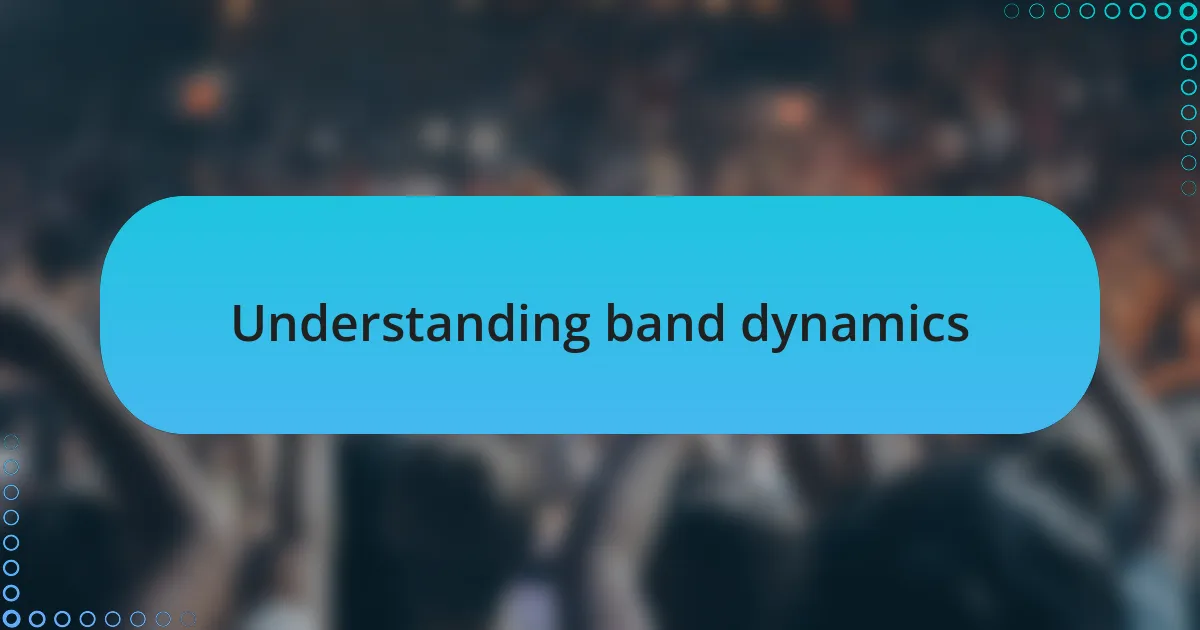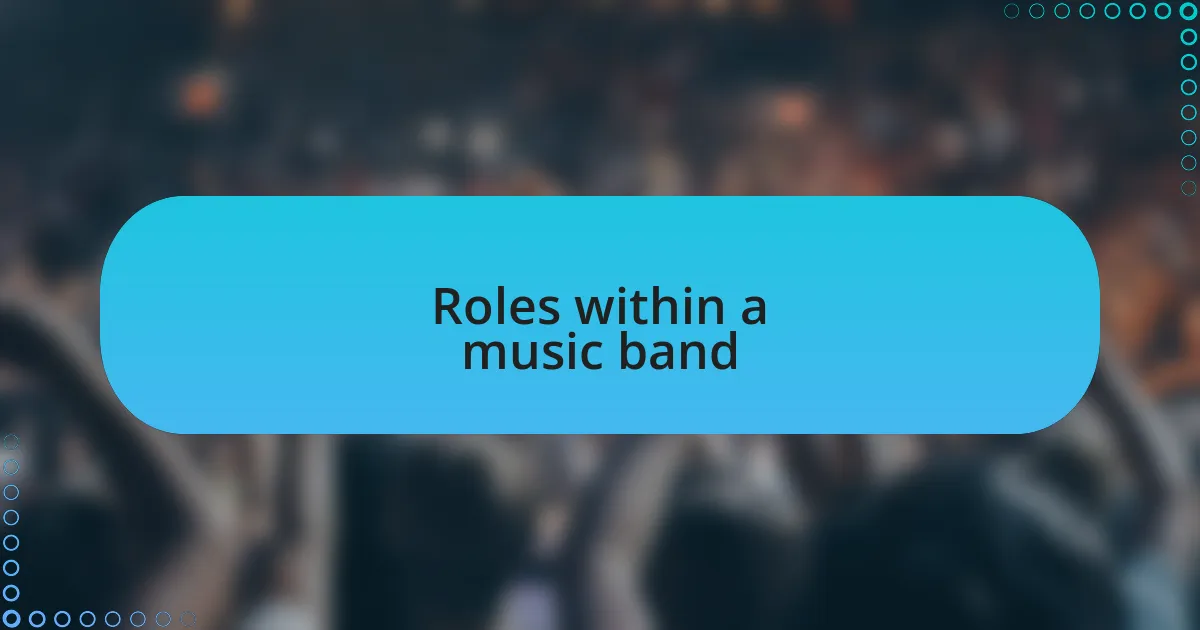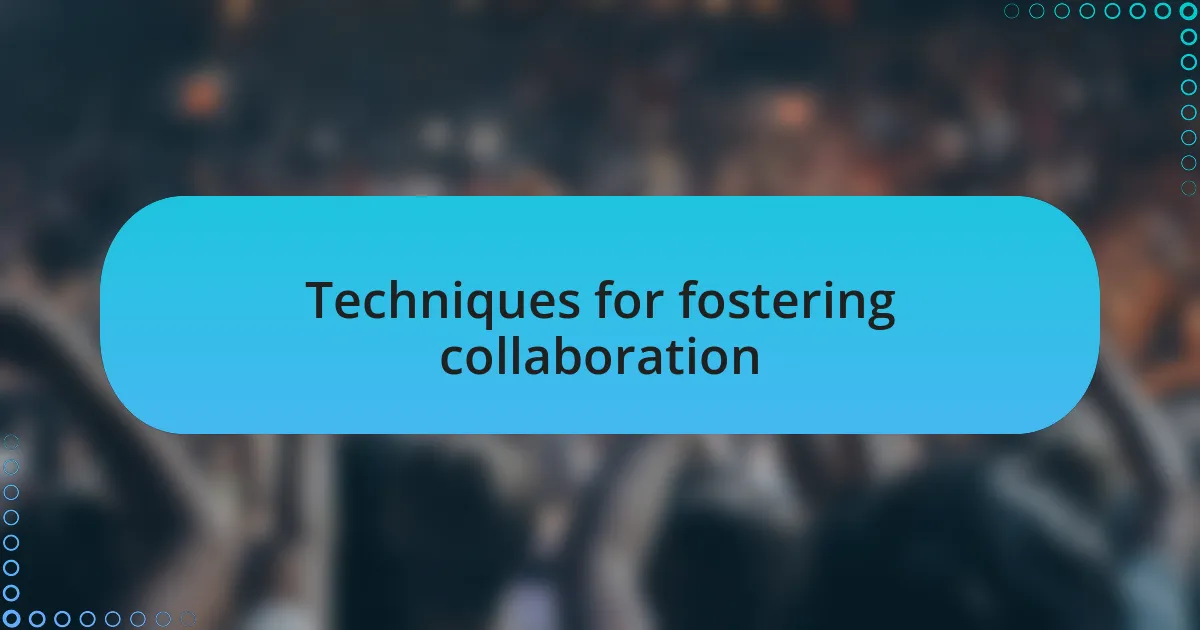Key takeaways:
- Open and honest communication fosters creativity and resolves conflicts effectively.
- Each band member’s unique role contributes to the overall sound and emotional depth of the music.
- Team-building activities outside of music can strengthen personal connections, enhancing collaboration.
- Vulnerability among bandmates builds trust and improves the group’s dynamic and creative output.

Understanding band dynamics
Band dynamics are fascinating and complex, often resembling a carefully choreographed dance. When I first joined a band, I quickly realized how crucial relationships are in shaping our sound and performance. I remember a particular rehearsal where differing opinions on a song arrangement led to a heated discussion, but ultimately, that clash of ideas brought out something beautiful in our music.
In every group, each musician has unique strengths and temperaments, which can create both synergy and tension. Have you ever felt the energy shift in a room when a new idea is introduced? It can be electrifying! From my experience, recognizing and valuing these diverse perspectives not only enhances creativity but also fosters a sense of belonging among members. This connection to one another can transform a mere group of musicians into a cohesive unit.
Communication is pivotal in navigating these dynamics. I’ve learned that open and honest conversations can help clear misunderstandings and build trust. Have you found that sometimes, a simple check-in can lead to deeper insights about a band member’s feelings? I recall one instance where a candid discussion not only resolved a conflict but also sparked inspiration for a new song, proving that understanding each other goes hand in hand with creating great music.

Importance of effective communication
Effective communication is the backbone of any successful band. I remember a moment when we were preparing for a gig, and one member seemed unusually quiet during our discussions. It struck me that he might be feeling overwhelmed, so I gently encouraged him to share his thoughts. When he finally spoke up, it was clear he had valuable insights that helped us refine our setlist. That experience reminded me how crucial it is to create an environment where everyone feels safe to express their opinions.
I’ve come to find that proactive communication can prevent issues before they even arise. For example, during a recent songwriting session, we decided to establish a simple rule: each of us would provide feedback without fear of judgment. This approach not only led to a more productive session but also strengthened our camaraderie. Have you ever experienced that moment when open dialogue sparks a wave of creativity? It’s invigorating, isn’t it?
At times, I’ve learned that effective communication goes beyond words. Body language and tone can convey just as much as what we say. I recall a time when a simple nod or smile during rehearsal encouraged a bandmate to push through a tough passage. That non-verbal support reminded me that communication encompasses everything we do—it’s not just about what we say, but how we connect with one another. Can you think of a moment in your own musical journey where silent encouragement made the difference?

Roles within a music band
When I think about roles within a band, it becomes clear how each member contributes uniquely to the group’s success. For example, I once played with a drummer who not only held the beat but also offered surprising arrangements that transformed our sound. That experience showed me that the drummer’s role goes beyond just keeping time; they can shape the band’s overall style.
Each position—whether it’s the lead singer, guitarist, bassist, or drummer—carries its own weight and significance. I remember a time when our bassist filled in as the emotional center during rehearsals. His thoughtful bass lines had a surprising way of conveying the song’s mood. Have you noticed how a well-placed note can pull the right emotions from listeners? It’s fascinating how the blend of roles creates a rich tapestry of sound that communicates deeper feelings to our audience.
Moreover, I believe that the relationships formed between musicians are just as important as the roles we hold. When I was jamming with a close group of friends, we naturally fell into our places without much discussion, trusting each other’s instincts. This trust allowed us to experiment boldly, knowing that each member was committed to supporting one another. Isn’t it amazing how the right chemistry can elevate a simple musical idea into something extraordinary?

Techniques for fostering collaboration
Encouraging open communication is one of the most effective techniques for fostering collaboration within a band. I remember a rehearsal where we held a casual roundtable discussion about our creative direction. Each member openly shared their thoughts, and it was enlightening to hear perspectives I hadn’t considered. Have you ever experienced a moment when sharing your vision drastically shifted the outcome? That conversation not only strengthened our connection but also led us to a more cohesive sound.
Another technique I find valuable is the practice of collaborative songwriting. When I sat down with a fellow guitarist to write a new track, we blended our ideas fluidly, with each contributing melodies and lyrics. There’s something magical about bouncing ideas off each other; it transforms songwriting from a solitary task into an exciting exchange. Have you noticed how collaboration can often illuminate aspects of a song you never saw alone?
Lastly, setting aside time for team-building activities has made a noticeable difference in our dynamic. I recall a weekend retreat where we spent more time hiking and sharing stories than rehearsing. That break from our usual routine fostered deeper connections, allowing us to understand one another beyond our musical roles. It becomes clear to me that these shared experiences build a solid foundation of trust—something essential for effective collaboration on stage and in the studio. What impact do you think such interactions have on the creative process? For me, they create a sense of unity, making us stronger together.

Strategies for conflict resolution
Addressing conflicts within a band can benefit greatly from implementing a few key strategies. I’ve found that when tensions flare, having a designated mediator—someone neutral who can facilitate discussions—often diffuses anger before it escalates. I recall a time when disagreements about our setlist led to a heated argument; bringing in our drummer, who wasn’t involved in the debate, helped us find common ground. Have you ever noticed how a fresh perspective can change the entire dynamic during a disagreement?
Another effective strategy I’ve implemented is the practice of active listening. During a recent rehearsal, I noticed two band members at odds over a song arrangement. By encouraging each of them to listen to the other’s suggestions without interruption, we were able to uncover solutions that satisfied both parties. Isn’t it fascinating how simply feeling heard can transform a conflict into a productive discussion?
Lastly, setting clear expectations for how we handle disagreements has been crucial. I remember we established a rule: if someone feels dissatisfied, they get two minutes to voice their concerns without interruptions. This rule has not only curtailed misunderstandings but has also fostered a culture where every opinion is valued. Have you experienced the relief that comes from knowing your voice will be heard? It’s remarkable how establishing such guidelines can elevate not just the resolution process but the entire atmosphere within the band.

Personal experiences with band dynamics
I’ve spent years navigating the complexities of band dynamics, and one unforgettable experience stands out. During a particularly challenging phase, we were struggling to gel as a group. I remember a moment when, after a series of frustrating rehearsals, I decided to organize a casual get-together outside of music. Over pizza and laughter, we connected as friends rather than just bandmates, and it transformed our collaboration into something more cohesive. Have you ever found that stepping away from the music can help mend the interpersonal threads of a group?
In another instance, our songwriting became a source of contention. I was deeply invested in my ideas, but I noticed the energy waning in the room. Instead of pushing my agenda, I suddenly changed my approach and invited everyone to contribute lyrics to a collective song. This shift allowed creativity to flow freely, and soon, what began as tension blossomed into a shared masterpiece. Isn’t it amazing how collaboration often leads to unexpected breakthroughs?
Reflecting on these experiences, I’ve realized the importance of vulnerability within the group. There was a time when I hesitated to share my personal struggles with the band, fearing it would undermine my authority. However, once I opened up about facing anxiety before performances, it created a wave of trust among us. My bandmates reciprocated with their own fears, reinforcing our bond. Can you relate to the power of sharing vulnerabilities? It’s remarkable how authenticity can not only strengthen relationships but also enhance our creative synergy.